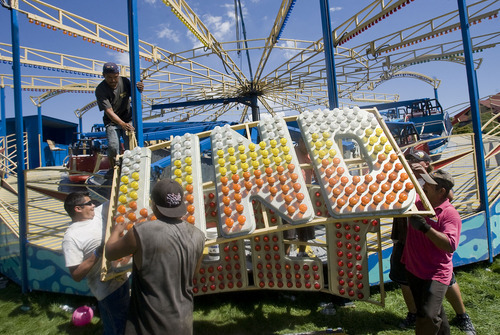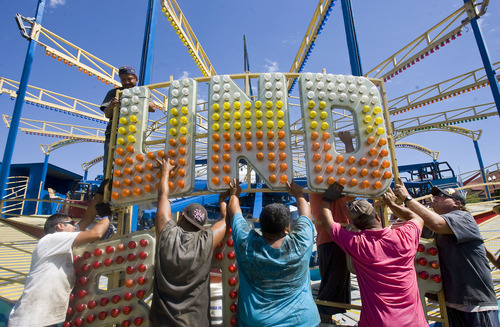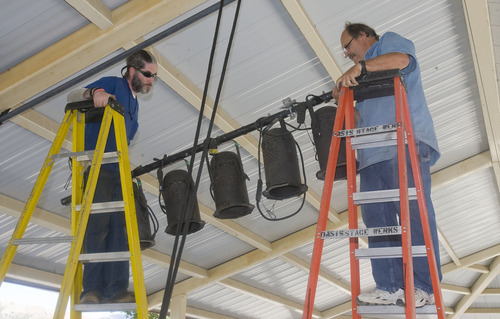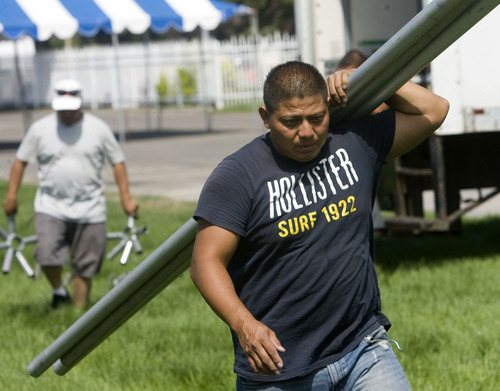This is an archived article that was published on sltrib.com in 2011, and information in the article may be outdated. It is provided only for personal research purposes and may not be reprinted.
There is a good reason Kevin McCarthy has contracted with the Utah State Fair for more than 20 years to help set up the cattle and dairy cow exhibits.
The Riverton man once ran beef cattle along the Wasatch Front, but as urban sprawl replaced farms and small ranches with homes and shopping centers, most agricultural areas disappeared.
"We have lost the concept and idea of where food comes from," he said. "People just say let's go to the supermarket and the food is there. But there is quite a process before then."
He views the Utah State Fair that opens Sept. 8 and runs through Sept. 18 as a chance to let exhibitors from around the state show off their prized livestock and to educate an increasingly urban population as to how food is produced.
The Utah State Fair began 156 years ago and moved to its present site in Salt Lake City's west side in 1902. Some of the original buildings will be used, though they have been renovated.
New Utah State Fair Executive Director Clark Caras feels a special bond to the event. He started showing sheep and cattle at the fair when he was an 8-year-old living in Spanish Fork. He thinks he still holds the 4H record for raising the champion lamb five straight years. Selling those champion animals to institutions such as the Hotel Utah helped him finance his college education.
"Every September was like Christmas," he said. "We would come and stay for almost all 11 days of the fair. It was exciting coming to the big city."
These days, the Utah State Fair combines a little bit of everything. Caras calls it the biggest and oldest farmers market and mall in the state.
The fair is a place where someone might dare you to eat chocolate-covered crickets and scorpions, a maggot melt sandwich, hamburgers where doughnuts serve as buns or deep-fried butter, all items that will be available this year. It might be a chance to see a performer such as Weird Al Yankovic put on a 2 1/2-hour concert with 11 costume changes. It could be a place to watch an outdoor rodeo, a demolition derby, a hypnotist, a seal show or a cow sculpted from butter.
This is where you go to see your favorite aunt win first prize for a giant pumpkin, view artwork and photos produced from around the state, let your grandchildren ride a pony, view the wildlife displays at the Fish and Game Building, eat cotton candy and experience the smells produced by farm animals such as goats, sheep, pigs and cows. It's where a boy tries to win a stuffed animal for his date and where friends dare each other to go on the biggest thrill ride in the carnival.
It might be a place to people watch or to wander through aisles of commercial exhibits where you can purchase a set of knives, some pots and pans, the world's best peeler, a salsa maker, potions with amazing healing powers, a funeral or toys found nowhere else.
Caras said his fair experience is never complete without purchasing fudge from a vendor that has been at the Utah State Fair for decades.
"The fair is one of the best places there is to come and watch people," he said. "It cuts across all aspects of society. Everybody smiles. Walk around the fairgrounds and the one thing you will notice is that everybody has a smile on their face."
The 10th anniversary of the Sept. 11 attacks on New York City will merit a special mention Sunday at the fair. The Salt Lake Men's Choir will perform a concert at the grandstand capped by fireworks. Active and retired members of the military and their families, police and firefighters will get in free by presenting their identification badges.
That's just one slice of Americana involved in the Utah State Fair, an event that has seen a little bit of everything in its 156 years.
wharton@sltrib.com Twitter @tribtomwharton —
Utah State Fair
P The fair opens today and continues to Sept. 18.
Where • Utah State Fairpark, 155 N. 1000 West, Salt Lake City
Regular admission • Adult, $10; senior (62 and older), $7; youth (6-12), $7; children (5 and younger), free; season admission pass, $40; parking, $6.
Carnival deals • All-You-Can-Ride day wristband, $25; matinee All-You-Can-Ride wristband, $18.
When • Sunday-Thursday, 10 a.m.-10 p.m.; Friday-Saturday, 10 a.m.-11 p.m.
Website • utah-state-fair.com —
Fun Utah State Fair facts
The first Utah State Fair was held in 1856 but was called the Deseret Fair. Mormon leader and Utah Territory Gov. Brigham Young received $25 for Best Stallion and first prize for Best Celery Exhibit.
The Utah Legislature purchased the 65 acres of what is now the Fairpark, originally called Agriculture Park, in 1902. Before then, the fair was held on the site of what is now the Joseph Smith Memorial Building, Market Row on 200 S. State, 100 S. West Temple, and the current site of Trolley Square.
The Horticulture Building, now named Promontory Hall, was constructed in 1902 and designed by local architects Walter Ware and Alberto Treganza, who also designed the First Presbyterian Church. It is still in use.
Food vendors will be serving a variety of traditional and not-so-traditional fare, including deep-fried butter, maggot melt sandwiches, raccoon on a stick, deep fried Twinkies stuffed with bacon, chocolate-covered crickets, Rocky Mountain oysters, rattlesnake, alligator on a stick, chocolate-covered bacon and deep-fried Snickers bars this year.
About 300,000 visitors attend the Utah State Fair every year.
The Utah State Fair is second only to the Days of '47 as Utah's longest-running event.
Source: Utah State Fair —
TRAX construction
TRAX construction on North Temple in front of the Utah State Fairpark could cause some delays. But Utah Transit Authority spokesman Gerry Carpenter said all parking lots will be accessible and there will be no full closures of the road during the event. Clark Caras, the fair's executive director, said there will be extra security to help people cross a new painted crosswalk at the Jordan River Bridge and that visitors will not have to walk through trenches.









